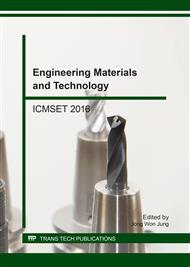[1]
W. Liese, The Anatomy Of Bamboo Culms, Technical Report - INBAR (International Network for bamboo and rattan) Beijing, People's Republic of China, (1998) 11-88.
Google Scholar
[2]
A. L. Beraldo, L. A. Rivero, Bambu Laminado Colado (BLC), Forest Environ. Mag. 10(2) (2003) 36-46.
Google Scholar
[3]
K. Ghavami, C. S. Rodrigues, S. Paciornik, Bamboo: Functionally Graded Composite Material, Asian J. Civil Eng. (Building Housing). 4(1) (2003) 1-10.
Google Scholar
[4]
H. Q. Yu, Z. -H. Jiang, C. -Y. Hse, T. F. Shupe, Selected physical and mechanical properties of moso bamboo (Phyllostachys pubescens), J. Trop. Forest Sci. 20(4) (2008) 258-263.
Google Scholar
[5]
O. H. Lopes, Bamboo the Gift of the Gods, first ed., Oscar Hidalgo Lopes, Colombia, (2003).
Google Scholar
[6]
R . Santhoshkumar, K. V. Bhat, Variation in density and its relation to anatomical properties in bamboo culms, Bambusa bambos (L. ) Voss, J. Plant Sci. 2(3) (2014) 108-112.
DOI: 10.11648/j.jps.20140203.12
Google Scholar
[7]
M. A. Latif, W. A. Wan, A. Fauzidah, Anatomical features and mechanical properties of three Malaysian bamboos, J. Trop. Forest Sci. 2(3) (1990) 227-234.
Google Scholar
[8]
E. J. Hearn, Mechanics of Materials, An Introduction to the Mechanics of Elastic and Plastic Deformation of Solids and Structural Materials, Ed. Oxford, Boston: Butterworth-Heinemann, (1997).
Google Scholar
[9]
S. Iwakiri, A. R. G. Montefusco, K. M. Zablonsky, K. P. Siqueira, L. K. Saldanha, M. A. M. Souza, Production of Strand" Particle Sheets with Laminar Inclusion – "Com-Ply, Forest Environ. 10(2) (2003) 30-35.
Google Scholar
[10]
Z. Wang, Y. Ren, A study on the physical properties of a bamboo moulding compared with wood and MDF mouldings, INBAR (International Network for bamboo and rattan) Beijing, People's Republic of China, 44 (2003).
Google Scholar
[11]
B. K. Brashaw, V. Bucur, F. Divos, R. Gonçalves, J. Lu, R. Meder, R. F. Pellerin, Nondestructive testing and evaluation of wood: A worldwide research update, Forest Prod. J. 59(3) (2009) 7-14.
Google Scholar
[12]
G. Vidaurre, L. R. Lombardi, L. Nutto, J. T. S. Oliveira, M. D. C. Arantes, Properties of Reaction, Forest and Environment Wood, Brazilian J. Wood Sci. 20(1) (2013) 26-37.
Google Scholar
[13]
L. C. Cossolino, A. H. A. Pereira, Elastic modules: overview and characterization methods. ATCP Physical Engineering, (2010) 1-30.
Google Scholar
[14]
Y. Huang, B. Fei, P. Weib, C. Zhao, Mechanical properties of bamboo fiber cell walls during the culm development by nanoindentation, Ind. Crops Prod. 92 (2016) 102-108.
DOI: 10.1016/j.indcrop.2016.07.037
Google Scholar
[15]
J. J. Garcia, C. Rangel, K. Ghavami, Experiments with Rings to Determine the anisotropic elastic Constants of Bamboo, Constr. Build. Mater. 31 (2012) 52-57.
DOI: 10.1016/j.conbuildmat.2011.12.089
Google Scholar
[16]
K. Ghavami, A. B. Marinho, Physical and mechanical properties of the whole stalk of bamboo of the species guadua angustifolia, RMNC Bambu 01/2001, PUC-Rio, (2001).
Google Scholar
[17]
K. E. Teftt, Relation Between Flexional Resonant Frequency Equations for the Flexional Vibration of Cilindrical Rods, J. Res. Natl. Bur. Stand. 64B(4) (1960) 237-250.
Google Scholar
[18]
L. E. R. Lapo, A. L. Beraldo, Bambu Laminado Colado (BLC), Magaz. Agribus. Environ. 1(2) (2008) 165-177.
Google Scholar
[19]
R. Gonçalves, A. Bartholomeu, Non-destructive test performance in beams of Eucalyptus citriodora and Pinus elliottii, Brazilian J. Agricult. Environ. Eng. 4(2) (2000) 269-274.
Google Scholar
[20]
NBR 7190. Brazilian Association of Technical Standards, Wood Framework Projects. Rio de Janeiro, (1997).
Google Scholar
[21]
ASTM E 1876-07. American Society of Testing matireals. Standard test method for dynamic Young's modulus, shear modulus, and Poisson's ratio by impulse excitation of vibration. New York, (2007).
DOI: 10.1520/e1876-01
Google Scholar
[22]
ISO 3130. International Organization for Standardization. Wood - Determination of moisture content for physical and mechanical test, (1975).
Google Scholar


